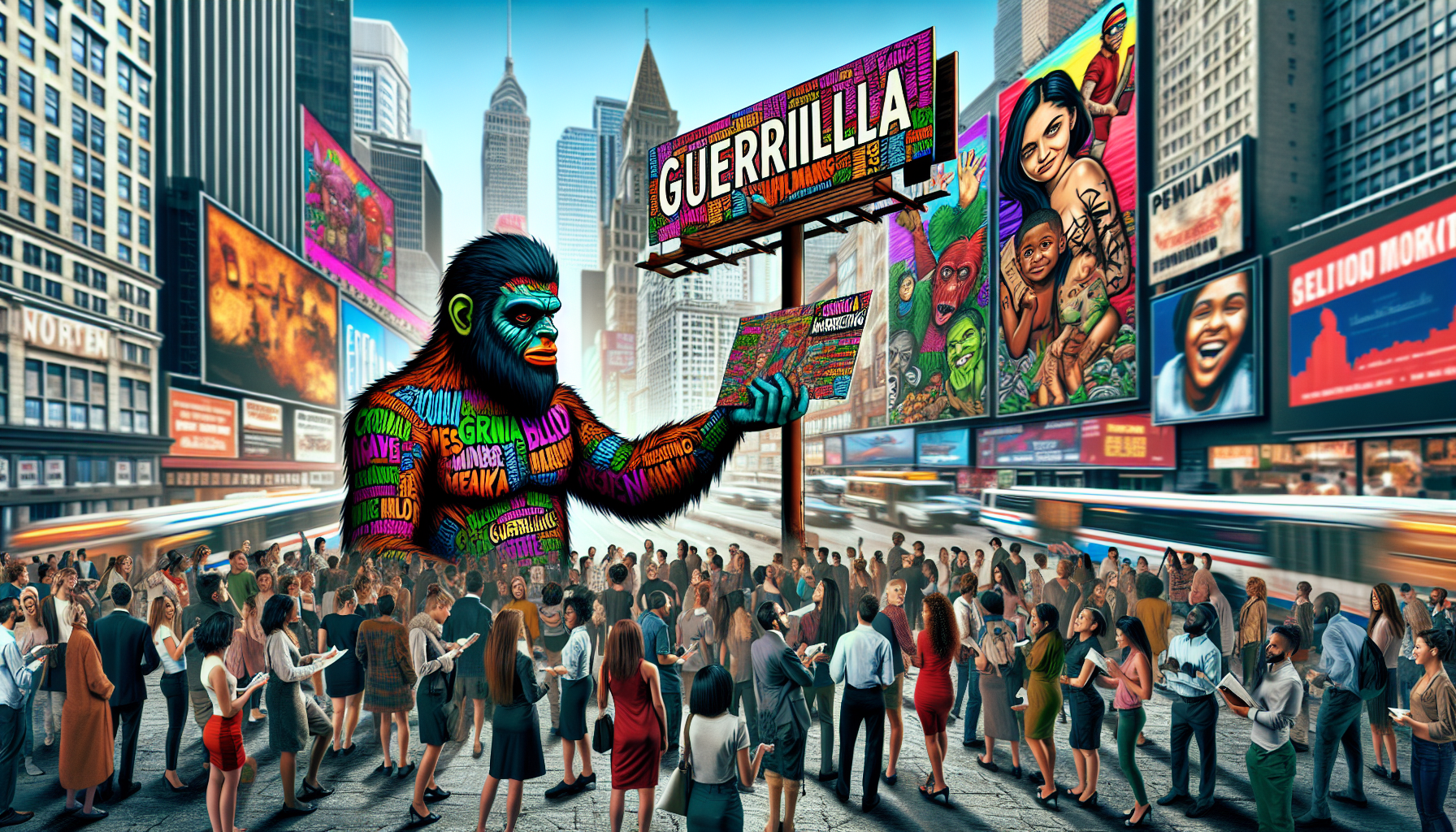Our journey through the full story of how guerrilla marketing changed advertising will explore its historical milestones, various approaches, and the pivotal role of creativity and innovation. We will examine how this strategy differs fundamentally from traditional marketing techniques, providing a comparative analysis highlighting its unique benefits and challenges. In doing so, we aim to offer insights into how guerrilla marketing continues influencing the advertising world, encouraging brands to think outside the box and forge deeper connections with their audience. Through this exploration, we hope to illuminate the dynamic and transformative power of guerrilla marketing, showcasing its potential to redefine advertising paradigms and chart new pathways to success.
Contents
Historical Milestones in Guerrilla Marketing
Initial Implementation
We find the roots of guerrilla marketing deeply embedded in the 1980s when Jay Conrad Levinson introduced the concept in his seminal book, “Guerrilla Marketing.” As a seasoned marketing consultant, Levinson proposed that small businesses could compete against giant corporations by employing low-cost, imaginative marketing strategies. His inspiration came from guerrilla warfare tactics, which rely on agility and surprise, paralleling the marketing techniques that use the element of surprise, humour, or shock to capture the audience’s attention.
Major Milestones
Over the years, guerrilla marketing has evolved significantly, demonstrating its adaptability to changes in consumer behaviour and technological advancements. The shift from traditional advertising mediums like print, radio, and television to electronic media marked a significant turning point. This transition underscored the necessity for marketers to adopt more direct and impactful engagement methods, leading to the rise of guerrilla marketing techniques that focus on creating memorable, buzz-worthy interactions with the audience.
One of the pivotal moments in the history of guerrilla marketing was its widespread adoption by small and medium-sized enterprises and large corporations. Organizations began to see the value of employing guerrilla tactics to stand out in a saturated market, often using social media to amplify their campaigns. The strategy’s cost-effectiveness and high impact made it particularly popular among startups and businesses with tight budgets, who found they could achieve significant brand awareness and consumer engagement without the hefty price tag associated with traditional advertising.
Moreover, the evolution of street marketing, a subset of guerrilla marketing, has expanded the scope of where and how campaigns can be executed. From mass-printed flyers to animated digital signage, the methods have grown to encompass a variety of platforms and formats, further enhancing the reach and effectiveness of guerrilla marketing campaigns.
In our ongoing exploration, it becomes clear that the historical milestones of guerrilla marketing are not just about the tactics themselves but also the broader implications for advertising strategies. By continuously adapting to the landscape and maintaining a focus on innovation and creativity, guerrilla marketing remains a powerful tool in the arsenal of modern marketers, capable of delivering exceptional results in an ever-changing market. However, it’s important to note that guerrilla marketing also comes with challenges and risks, such as potential legal issues or negative public perception, if not executed carefully.
Different Approaches to Guerrilla Marketing
Projection Advertising
Projection advertising is a dynamic facet of guerrilla marketing in which large, eye-catching advertisements are displayed on buildings or blank walls. This approach personalizedizes promotions tailored to specific events or locales, offering a flexible and less capital-intensive alternative to permanent advertisements. Projection advertising is often informal and can be set up with minimal upfront investment. It is an attractive option for companies to maximise their event visibility without the long-term commitments typically associated with traditional advertising.
Event Ambush Marketing
Event ambush marketing is another intriguing strategy within guerrilla marketing. This tactic involves promoting a product or service at a pre-existing event, often without official sponsorship status. By appearing to be an event sponsor, companies engage in what is known as coattail marketing. This approach saves money and capitalises on the large audience gathered for the event. It’s a bold move that can catch attendees by surprise, creating a memorable brand experience. Examples include unexpected advertisements at sports events or festivals, where the element of surprise enhances the impact of the marketing message.
Experiential Marketing
Lastly, experiential marketing, or participation or live marketing, is a cornerstone of guerrilla marketing strategies. This approach involves creating immersive, pop-up experiences that allow consumers to engage directly with a brand. Experiential marketing aims to make the brand a tangible part of the consumers’ environment, whether it’s a free sample, interactive installations, or unexpected urban interventions. Notable campaigns have turned mundane activities, like climbing stairs, into engaging experiences that significantly increase consumer interaction with the brand. For instance, Volkswagen transformed subway stairs into piano keys, leading to a 66% increase in people choosing the stairs over the escalator. This method entertains and deeply embeds the brand in the participants’ memory, enhancing both reach and consumer perception.
The Role of Creativity and Innovation
Creative Thinking
In guerrilla marketing, the infusion of creativity and innovation is not just beneficial; it’s essential. Brands transform everyday spaces into captivating, interactive canvases by weaving marketing messages into street art and public installations. These methods enhance the visual appeal and engage the public in unexpected, memorable experiences that generate significant word-of-mouth buzz. Historically, street art has evolved from a subversive culture into a potent commercial messaging tool, employing vibrant visuals and strategic placements to maximize visibility and impact.
Adopting creative unboxing experiences in the e-commerce sector exemplifies this innovative spirit. Brands like Apple and Glossier have redefined the first customer interaction with their products through meticulously designed packaging. Apple’s minimalist, elegant packaging creates a sense of anticipation and delight, echoing the quality of the product inside. Similarly, Glossier’s iconic pink bubble wrap pouches protect the product and double as a desirable, reusable accessory, enhancing brand recall and offering a unique value proposition.
Case Studies
Adidas and Coca-Cola have successfully harnessed the power of guerrilla marketing through creative campaigns that resonated deeply with their target audience. During the 2014 FIFA World Cup, Adidas created a series of street art murals in key cities featuring famous football players, effectively heightening event excitement and strengthening the brand’s association with street culture and sports. On the other hand, Coca-Cola transformed ordinary vending machines into sources of surprise and delight. These machines dispensed unexpected gifts like flowers or pizza, creating viral, happiness-dispensing moments that captivated audiences worldwide.
Guerrilla marketing’s reliance on creativity and innovation extends beyond visual and physical interactions. It encompasses a deep understanding of the target audience and a willingness to engage them in unconventional ways. This approach often includes elements of surprise or shock, which capture attention and foster an emotional connection with the audience, thereby building brand loyalty and enhancing customer engagement.
By leveraging these creative strategies, guerrilla marketing distinguishes itself from traditional marketing and establishes a unique, impactful presence in the competitive market. This approach allows businesses, especially those with limited budgets, to achieve significant results without the extensive costs typically associated with conventional advertising.
Comparative Analysis with Traditional Marketing
Cost Efficiency
Guerrilla marketing is renowned for its cost-effectiveness. Unlike traditional marketing, where substantial budgets are often necessary, guerrilla marketing leverages creativity and innovation, significantly reducing expenses. The average cost of a guerrilla marketing campaign is approximately $1,000, which is drastically lower compared to the budgets required for conventional campaigns. This affordability makes it particularly appealing to startups and small businesses that might not have significant marketing funds but still wish to make a substantial impact.
Impact on Sales
Implementing guerrilla marketing strategies can lead to a notable increase in sales. Reports indicate that these tactics can boost sales by up to 30%. This significant impact is attributed to guerrilla marketing campaigns’ memorable and engaging nature, which often leaves a lasting impression on consumers. The direct and interactive approach of guerrilla marketing captivates attention and encourages sharing, thereby increasing the potential for sales growth.
Consumer Engagement
Guerrilla marketing excels in creating personalised and memorable experiences for consumers. Statistics show that 86% of consumers find guerrilla marketing campaigns more memorable than traditional advertising. Furthermore, 70% of customers consider these strategies mpersonalizedised, enhancing the consumer-brand relationship. The interactive nature of guerrilla marketing, often involving direct contact with the target audience, helps build stronger brand loyalty and encourages higher levels of engagement. Additionally, guerrilla marketing initiatives are reported to be more eye-catching, with 95% of customers agreeing to their distinct appeal compared to regular advertising.
By focusing on creativity and direct engagement, guerrilla marketing not only cuts down costs but also significantly enhances consumer interaction and sales potential, making it a powerful tool in contrast to traditional marketing methods.
While exploring guerrilla marketing’s transformative role in advertising, we have seen its potential to invigorate traditional marketing practices with creativity, innovation, and cost-efficiency. It becomes apparent that by stepping outside conventional boundaries, brands can engage consumers in a more meaningful, memorable way. The comparative analysis with traditional marketing underscores guerrilla marketing’s unparalleled ability to create lasting impressions and generate significant word-of-mouth buzz while being remarkably cost-effective. These strategic advantages benefit startups and small businesses and provide valuable insights for established companies seeking to renew their connection with their audience.
The significance of guerrilla marketing extends beyond immediate sales boosts; it fosters a deeper brand-consumer relationship by turning everyday interactions into memorable experiences. As highlighted through various approaches and case studies, the call for creativity and innovation in campaign design illustrates a shift towards a marketing paradigm that prioritises engagement and experience.





